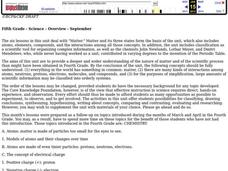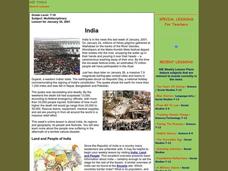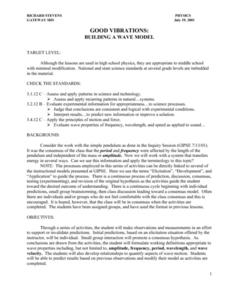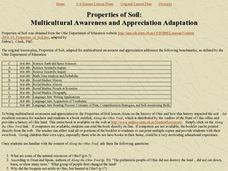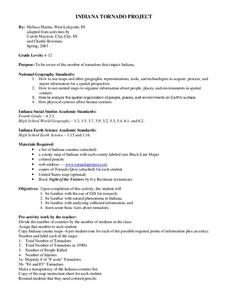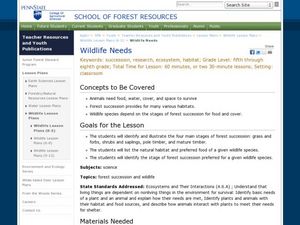Curated OER
Matter
Fifth graders investigate the nature of matter and of the scientific processes associated with them in this series of lessons.
Curated OER
Why Are Volcanoes Dangerous?
Students investigate the causes and characteristics of volcanic eruptions including pyroclastic eruptions. They study the effects of natural disasters.
Curated OER
Paper Bag Zoo
Students create animals that might be found in a zoo using paper bags, construction paper, and other materials. They present their animal to the class stating any facts that they may know about the animal and its habitat.
Curated OER
Watercycle
Third graders examine the natural circulation of water from oceans, lakes, and rivers to evaporation into the air, and then to condensation to produce rain falling back to the soil as components of the water cycle.
Curated OER
India
Students discuss the land and peoples of India. They examine the effects of the earthquake that occured on the Indian holiday of Republic Day in 2001. They make a list of items they would need in an emergency or natural disaster.
Curated OER
Working with Clay
Second graders investigate how to work with clay after examine the book "Being Friendly to Trees." They make a clay square which they decorate with leaves that they find while taking a nature walk. They glaze their artwork and then...
Curated OER
My Monkey in the Jungle
Second graders create depictions of a monkey in its' natural habitat. Emphasis is placed on the artwork of Henri Rousseau and techniques of landscape and design. State standards are addressed in this lesson.
Curated OER
Water 3: Melting and Freezing
Learners understand that most substances may exist as solids, liquids, or gases depending on the temperature, pressure, and nature of that substance. This knowledge is critical to understanding that water in our world is constantly...
Curated OER
Good Vibrations: Building a Wave Model
Young scholars assess and apply recurring patterns in natural systems. They evaluate the wave properties of frequency, wavelength, and speed as applied to sound. Students develop a relationship to quantify aspects of wave motion. They...
Curated OER
Oceanography
Fifth graders use scientific skills and processes to recognize how living things depend on one another and on the environment for survival and that the human use of natural resources impacts the environment. They research how Earth's...
Curated OER
Taking it to the Streets
Students explain the concept of cultural diffusion. They give examples of cultural diffusion throughout history; e.g. the development of Cuban music and dance. Students explain how cultural diffusion impacts civilizations, past and...
Curated OER
Properties of Soil
Young scholars use history to create knowledge of how soil has changed in the state of Ohio. The instructional activity is cross curricular in nature and uses Along the Ohio Trail as a source of literature for reflection.
Curated OER
Indiana Tornado Project
Students become aware of the number of tornadoes that impact Indiana. They explore basic facts about tornadoes. Students use the GIS for research. They explore that natural phenomena in Indiana. Students become familiar with...
Curated OER
Depicting Women and Class in a Global Society
Students analyze the evolution of women's work from the 19th century to present day and create artwork depicting women. In this women's roles lesson, students compare and contrast the use of space and color in the two paintings depicting...
Curated OER
Strawberry Girl: Outdoors in Florida
Students explore nature by researching the state of Florida. In this animal identification lesson plan, students read a children' story and research the Internet to discover the difference in animal life between the early 1900's and...
Curated OER
Temperature and Enzymes
Students compare the times it takes the milk in each of two cups to curdle. They are told that an enzyme that is added to the milk, rennin, is involved in the natural curdling process of milk. Students are asked to consider what...
Curated OER
Water and the Earth
In this water and Earth learning exercise, students read a 2 page article on water and the Earth, name the clouds in 2 pictures and then list 4 sources of water in nature.
Curated OER
Renewable Resources: Ancient Civilizations
Learners examine how ancient people used natural resources. In this renewable resource lesson, students will be put into 5 groups each focusing on a different past civilization. Each group will identify they types of resources their...
Curated OER
Wildlife Needs
Students identify the wildlife needs in a specific setting. In this wildlife needs lesson plan, students identify and illustrate the four stages of forest succession. Students list the natural habitat and food for a given species....
Curated OER
Are You One of Us?
Students investigate how scientists sort and classify organisms. For this sorting and classifying lesson, students examine what systematics are as tools that scientists use. They examine images of invertebrates and sort them while...
Curated OER
Turn of the Century
Young scholars explore the transformation of America's economy in response to the Industrial Revolution in terms of patterns of agricultural and industrial development relating to climate, natural resource use, markets and trade.
Curated OER
Comets
Students explore the nature and composition of a comet. They research comet facts, legends, and myths. They identify different types of comets and describe what happens to a comet as it travels closer to the Sun.
Curated OER
Finding Fibonacci
Students study and apply the Fibonacci numbers and how they occur in nature. Students solve problems using the Fibonacci numbers.
Curated OER
Are Chickens Really "Chicken"?
Learners practice their reading comprehension skills by reading about chickens. They state the characteristics of chickens and examine how growing up on a farm and being in the wild is different for the chickens.
